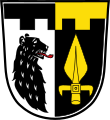
Franconia is a region of Germany, characterised by its culture and East Franconian dialect. Franconia is made up of the three Regierungsbezirke of Lower, Middle and Upper Franconia in Bavaria, the adjacent, Franconian-speaking South Thuringia, south of the Thuringian Forest—which constitutes the language boundary between Franconian and Thuringian—and the eastern parts of Heilbronn-Franconia in Baden-Württemberg.

The House of Hohenzollern is a formerly royal German dynasty whose members were variously princes, electors, kings and emperors of Hohenzollern, Brandenburg, Prussia, the German Empire, and Romania. The family came from the area around the town of Hechingen in Swabia during the late 11th century and took their name from Hohenzollern Castle. The first ancestors of the Hohenzollerns were mentioned in 1061.

The Principality of Bayreuth or Margraviate of Brandenburg-Bayreuth was an immediate territory of the Holy Roman Empire, ruled by a Franconian branch of the Hohenzollern dynasty. Since Burgrave Frederick VI of Nuremberg was enfeoffed with the Margraviate of Brandenburg in 1415/17, the Hohenzollern princes transferred the margravial title to their Franconian possessions, though the principality never had been a march. Until 1604 they used Plassenburg Castle in Kulmbach as their residence, hence their territory was officially called the Principality of Kulmbach or Margraviate of Brandenburg-Kulmbach until the Empire's dissolution in 1806.

The House of Hohenlohe is a German princely dynasty. It formerly ruled an immediate territory within the Holy Roman Empire, which was divided between several branches. In 1806, the area of Hohenlohe was 1,760 km² and its estimated population was 108,000. The motto of the house is Ex flammis orior. The Lords of Hohenlohe were elevated to the rank of Imperial Counts in 1450, and from 1744, the territory and its rulers were princely. In 1825, the German Confederation recognized the right of all members of the house to be styled as Serene Highness, with the title of Fürst for the heads of its branches, and the title of prince/princess for the other members. From 1861, the Hohenlohe-Öhringen branch was also of ducal status as dukes of Ujest.
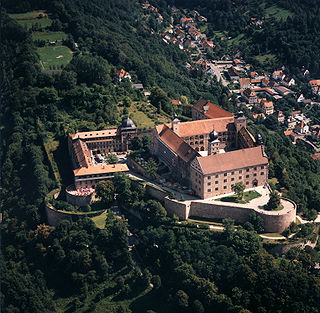
Plassenburg is a castle in the city of Kulmbach in Bavaria. It is one of the most impressive castles in Germany and a symbol of the city. It was first mentioned in 1135. The Plassenberg family were ministerial of the counts of Andechs and used as their seat the Plassenburg. The House of Guttenberg, a prominent Franconian noble family, traces its origins back to 1149 with a Gundeloh v. Blassenberg (Plassenberg). The name Guttenberg is derived from Guttenberg and was adopted by a Heinrich von Blassenberg around 1310. From 1340, the Hohenzollerns governed from Plassenburg castle their territories in Franconia till 1604. The Plassenburg was fortress and residence for the Hohenzollerns.

The Aufseß family, sometimes spelt Aufsees and Aufsess, is a Franconian noble family of Barons. The original family seat was at Unteraufseß castle in Aufseß, Upper Franconia. Members of this family held important Roman Catholic Church posts in Bamberg.

The House of Bibra was one of the leading Uradel families in Franconia and present day Thuringia from the mid-15th century to about 1600. Later on the family rose from Reichsritter to Reichsfreiherr. After the Holy Roman Empire dissolved, they were made ‘’Freiherr’‘ (Barons) of Bavaria and Bohemia.

Röttenbach is a town in the district of Erlangen-Höchstadt, in Bavaria, Germany.

The Guttenberg family is a wealthy Franconian family that was noble until all legal privileges of royalty and nobility were abolished in Germany in 1919 following the German revolution and proclamation of the republic at the end of World War I. It traces its origins back to 1149 with a Gundeloh von Blassenberg (Plassenberg), though the first mention in a document is dated 1158. The name Guttenberg is derived from Guttenberg in present-day Bavaria, and it was adopted by a Heinrich von Blassenberg around 1310.

The House of Franckenstein is the name of a feudal, Franconian noble family in Germany, descendants from the Dynasts of the Breuberg family; offsprings of the Lords of Lützelbach from Höchst im Odenwald.

The Bibran-Modlau family was a Silesian noble family which was raised to Reichsfreiherr 1624.

The Steigerwald is a hill region up to 498.5 m above sea level (NHN) in the Bavarian-Franconian part of the South German Scarplands between Würzburg and Nuremberg. It is part of the Keuper Uplands, and within it, it is continued to the north-northeast and right of the river Main, by the Haßberge, and to the south-southwest by the Franconian Heights. Part of the region is a designated as the Steigerwald Nature Park.
Friedrich Wilhelm Leopold Konstantin Quirin Freiherr von Forcade de Biaix, aka Friedrich Wilhelm Leopold Konstantin Quirin von Forcade de Biaix, Herr of Schleibitz, Hamm, Groß-Naedlitz and Loslau, aka the Baron von Forcade,, Royal Prussian Major, Knight of the Iron Cross 2nd Class on 26 August 1813, knighted by His Majesty Frederick William III of Prussia as Knight of the Order of Saint John in 1817, Royal Prussian Chamberlain (Kammerherr) and Castellan (Drost) of Neuenrade in the County of Mark, after his father's death in 1808. He was also a publisher, author, and theater director.

Franconia is a region that is not precisely defined, but which lies in the north of the Free State of Bavaria, parts of Baden-Württemberg and South Thuringia and Hesse in Germany. It is characterised by its own cultural and linguistic heritage. Its history began with the first recorded human settlement about 600,000 years ago. Thuringii, Alemanni and Franks, who gave the region its name, settled the area in the Early Middle Ages. From the mid-9th century, the Stem Duchy of Franconia emerged as one of the five stem duchies of the Empire of East Francia. On 2 July 1500, during the reign of Emperor Maximilian I, as part of the Imperial Reform, the empire was divided into Imperial Circles. The Franconian Circle, which was formed as a result of this restructuring, became decisive in the creation of a Franconian national identity. A feature of Franconia in the Middle Ages and Early Modern Period was its Kleinstaaterei, an extreme fragmentation into little states and territories. In the 19th century under Napoleon, large parts of Franconia were incorporated into the newly created Kingdom of Bavaria.
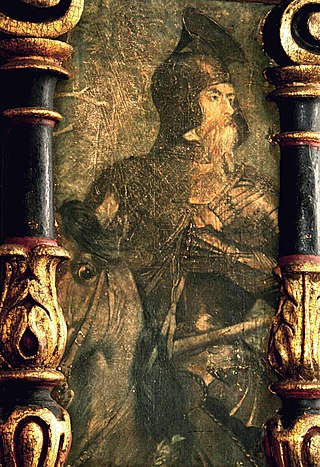
The Franconian War was waged in 1523 when the Swabian League attacked several robber baron castles in Franconia, whose nobles were supporters of Hans Thomas of Absberg in the Absberg Feud.
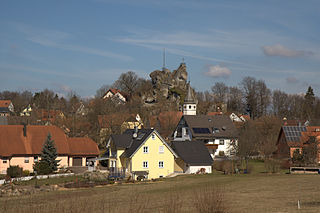
Wichsenstein Castle was a hill castle, once owned by noblemen, on a steep and prominent rock reef (Felsriff) outcrop above the church village of Wichsenstein in the Upper Franconian county of Forchheim in Bavaria, Germany. The castle has been completely demolished and there are no visible remains. The castle rock is now just used as a viewing point.

The ruins of Bärnfels Castle are the remains of a late mediaeval aristocratic castle on the southern edge of the village of Bärnfels in the municipality of Obertrubach in the Upper Franconian county of Forchheim in Bavaria. The ruins of the spur castle are freely accessible.
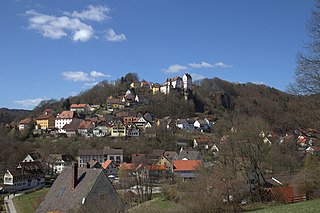
Egloffstein Castle is a former high mediaeval, aristocratic castle, that stands immediately west of the eponymous village of Egloffstein in the Upper Franconian county of Forchheim in the German state of Bavaria.

Schloss Hundshaupten is a quadrangular castle in the village of Hundshaupten in the municipality of Egloffstein in the German county of Forchheim.

Schloss Kunreuth is situated on the northwestern edge of the eponymous village of Kunreuth which is part of the collective municipality of Gosberg in the county of Forchheim, in the province of Upper Franconia in the south German state of Bavaria.








